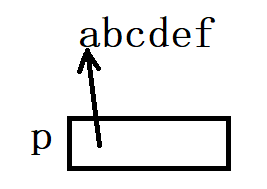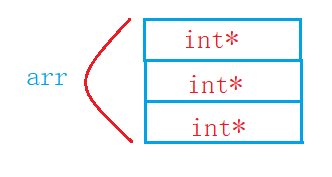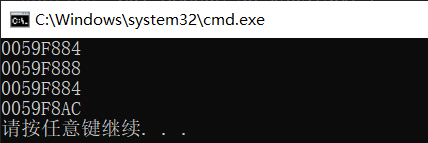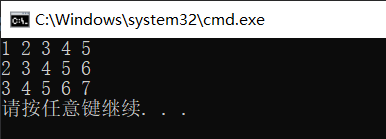What is the needle in front? This article has written the basic knowledge of pointers, and then through this article to have a deeper understanding of pointers
catalogue
6, Pointer to array of function pointers
1, Character pointer
The creation of character pointer is also very simple. char * type can access up to one byte of space at a time
See the following code:
#include <stdio.h>
int main()
{
char s = 'm';
char* ps = &s;
printf("%c\n", *ps);
*ps = 'w';
printf("%c\n", *ps);
return 0;
}This is the pointer creation and access operation. The operation results are as follows:

The main thing about character pointers is the following
int main()
{
char* p = "abcdef";
}Is the string "abcdef" saved in the pointer p?
abcdef has a total size of 7 bytes, while char * has only 4 bytes on the 32-bit platform. It can't be stored at all, so it doesn't directly store the whole string in the pointer p
Note that the first character address of this string is given to p


This writing method is not too rigorous. Under some compilers, errors will be reported. Please modify it again
int main()
{
const char* p = "abcdef";
}2, Pointer array
As the name suggests, a pointer array is an array of pointers
Look at the array in the following code
int* arr1[6]; //Array of integer pointers char* arr2[8]; //Array of first level character pointers char** arr3[7]; //Array of secondary character pointers
Next, create an integer pointer array
#include <stdio.h>
int main()
{
int a = 0;
int b = 1;
int c = 2;
int* arr[3] = { &a,&b,&c };
int i = 0;
for (i = 0; i < 3; i++)
{
printf("%d ", *arr[i]);
}
}Here, an integer pointer array is created and initialized. The addresses of a, B and C are stored in it, and then a, B and C are printed by dereference
Operation results:

As shown below:

Each element in this array is an integer pointer
Deepen your understanding through the following code
#include <stdio.h>
int main()
{
int arr1[] = { 1,2,3 };
int arr2[] = { 4,5,6 };
int arr3[] = { 7,8,9 };
int* arr[] = { arr1,arr2,arr3 };
int i = 0;
for (i = 0; i < 3; i++)
{
int j = 0;
for (j = 0; j < 3; j++)
{
printf("%d ", arr[i][j]);
}
}
return 0;
}Create a pointer array through this code, access it, and print
3, Array pointer
Array pointer is a pointer to the array, which stores the address of the array
The form of array pointer is as follows:
int main()
{
int arr[10] = { 1,2,3,4,5,6,7,8,9,10 };
int(*p)[10] = &arr;
}p here is first combined with * to show that it is a pointer. What is it pointing to? It points to an array with 10 elements, and the type of each element is int
Array name and & array name
The array name is the address of the first element of the array, and the & array name is the address of the whole array
See the following code:
#include <stdio.h>
int main()
{
int arr[10] = { 1,2,3,4,5,6,7,8,9,10 };
printf("%p\n", arr);
printf("%p\n", &arr[0]);
printf("%p\n", &arr);
return 0;
}Operation results:

Through this running result, you will find that the three printed values are the same
Are array names and & array names really the same? Let's take another look through the following code:
#include <stdio.h>
int main()
{
int arr[10] = { 1,2,3,4,5,6,7,8,9,10 };
printf("%p\n", arr);
printf("%p\n", arr + 1);
printf("%p\n", &arr);
printf("%p\n", &arr + 1);
return 0;
}Operation results:

You can see that the printed results are different after giving & arr and arr+1 respectively. arr+1 skips one integer and four bytes, while & arr+1 directly skips the whole array
Use of array pointers
The use of array pointers is generally used for two-dimensional arrays
The following code: access the two-dimensional array through the array pointer
#include <stdio.h>
print(int (*p)[5], int x, int y)
{
int i = 0;
for (i = 0; i < x; i++)
{
int j = 0;
for (j = 0; j < y; j++)
{
printf("%d ", (*(p + i))[j]);
}
printf("\n");
}
}
int main()
{
int arr[3][5] = { {1,2,3,4,5},{2,3,4,5,6},{3,4,5,6,7} };;
//Access the array as a pointer through the following function
print(arr, 3, 5);
}Operation results:

4, Function pointer
A function pointer is a pointer to a function -- the address where the function is stored
Function address
We can first experience it through the following code:
#include <stdio.h>
void test()
{
}
int main()
{
printf("%p\n", &test);
}Operation results:

The address of the function is printed here
To know that the array name represents the address of the first element of the array, will the function name also be the address of the function?
Verify with the following code:
#include <stdio.h>
void test()
{
}
int main()
{
printf("%p\n", &test);
printf("%p\n", test);
}
You can see that the printed results are the same, so you can determine that the function name represents the address of the function
Function name and & function name are the addresses of functions, and there is no difference
Function pointer creation
The following code:
#include <stdio.h>
int Add(int x, int y)
{
return x + y;
}
int main()
{
int (*ps)(int, int) = Add;
return 0;
}Here * p indicates that ps is a pointer, the following (int,int) indicates that the pointer points to a function, and the previous int indicates that the return value of the function is int
Use of function pointers
We can call the pointed function through the function pointer
The following code:
#include <stdio.h>
int Add(int x, int y)
{
return x + y;
}
int main()
{
int (*ps)(int, int) = Add;
int add = (*ps)(1, 2);
printf("%d\n", add);
return 0;
}Operation results:

In fact, we put Add in ps. in fact, ps and Add should be the same. In fact, the * used here has no practical effect. We can also use the following writing method
int add = ps(1, 2);
5, Function pointer array
It stores function pointers
The following code:
int add(int x, int y)
{
return x + y;
}
int sub(int x, int y)
{
return x - y;
}
int main()
{
//Function pointer array
int (*pf[5])(int, int) = { add,sub };
}In the above code is the function pointer array
pf[5] indicates that it is an array. The rest indicates that each element in it is a function pointer. The function pointed to is two parameters of type int, and the return type bit is int
Function pointer array is mainly used to transfer tables
Before C language implementation of simple calculator This article has written the usage of function pointer array and uses transfer table to realize simple calculator. You are welcome to read it. We won't move that code here
6, Pointer to array of function pointers
This is a pointer. The pointer points to an array. Each element in the array is a function pointer
Because there are very few pointers to the function pointer array, we won't expand the introduction here
The following code example:
int (*psa)(int, int); //Function pointer
int (*ps[5])(int, int); //Function pointer array
int (*(*pps)[5])(int, int) = &ps; //Pointer to array of function pointers
Note: how to judge which type of pointer is mainly depends on the combination and priority of operators
-----------------------------------------------------------------
-----------------Partial completion of C language operators-------------------
About C language, each knowledge point will be introduced in more detail in a separate blog
Welcome to pay attention!!!
Learn and communicate together!!!
Let's finish the programming!!!
--------------It's not easy to organize. Please support the third company------------------